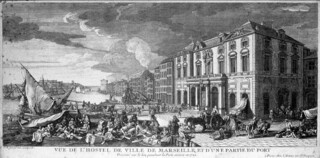In Marseille
Harry Stopes
The plague first came to Marseille on a ship from Spain in 588, forty-seven years after the disease’s appearance in the Eastern Mediterranean marked the beginning of the first pandemic. ‘Many citizens bought various merchandise’ from the ship, according to Gregory of Tours. ‘The fire of the plague did not at once spread through all the houses, but after a definite time like a fire in standing grain it swept the whole city with the flame of disease.’
The second plague pandemic began in the 14th century with the Black Death. Trading states and cities across the Mediterranean Basin developed a patchwork of public health systems to manage the flow of suspect goods and people. From the 16th century, sailors and merchandise arriving in Marseille were confined at the lazaret on the island of Pomègues.
By the 18th century the city had a three-tier system of 15 to 60-day quarantine. The period of confinement depended on the health of the crew, the origin of the ship – the Levant and North African coast were considered more suspect – and whether the captain could provide letters attesting to a healthy situation in his recent ports of call.
The system was effective, but not perfect – Marseille was the site of the last major outbreak of plague in Western Europe. Between 1720 and 1722 around half the city’s population of 90,000 died, along with a similar number elsewhere in Provence. The outbreak is the subject of Marseille en temps de peste, a new exhibition atthe Musée d’Histoire de Marseille. The museum overlooks the ancient port where the Spanish plague ship docked.
Le Grand Saint Antoine arrived on 25 May 1720 from the Eastern Mediterranean via Livorno. It was loaded with cotton and silk cloths worth around 100,000 crowns. The ship’s investors intended to sell the merchandise at Beaucaire, a city on the Rhône between Nîmes and Avignon, whose annual fair was the largest in southern France. Under the strictest quarantine conditions, however, the cargo would be released too late for the fair.
One of the investors was Jean-Baptiste Estelle, a powerful figure in the city government. The exhibition implies he may have had something to do with Le Grand Saint Antoine’s quarantine being laxly enforced. The ship and its remaining wares – those that had not mysteriously escaped the lazaret – were burnt in September, but the city was already infected.
The local authorities at first denied that the mysterious deaths of late June and early July were caused by the plague, fearing the effect on commerce. ‘A malign fever caused by bad diet’ was the official position, but it quickly became untenable. On 31 July the parliament of Provence banned all commerce and communication between the city and the region. Movement through the streets was limited, schools were closed, funeral rites regulated, and citizens ordered to burn sulphur in their homes to purify the air.
By the end of August deaths had reached around a thousand a day. A priest had an ironworker make a six-foot set of pincers for socially distanced administration of the sacraments. They are on display at the museum along with smaller tongs for holding letters while disinfecting them in vinegar, medical tools for applying heat to or cutting buboes, texts on treatments, a beaked plague mask, and a public appeal from the city offering 1000 to 2000 livres a month for surgeons to come and work there.
In early September, the royal authorities appointed Charles-Claude Andrault de Langeron as an extraordinary executive in Marseille. Six companies of soldiers were dispatched to clean up the city, arrest looters, gather corpses, close gambling dens, collect waste, reorganise the hospital and register the dead. Ordinances were issued against throwing stones or firing arms in the city. The shops, however, were kept open.
The bodies piled up in mass graves. Examining a site in Le Panier in the early 2000s, archaeologists found definitive evidence of the Yersinia pestis bacterium. Responsible for the third plague pandemic, which began in China in 1855, the bacillus is now known to have caused the first two as well.
The permanent exhibition at the Musée d’Histoire describes Marseille as ‘a mixed picture … a poor city characterised by criminal gangs settling their scores, but also an attractive lively city where culture and tourism have become prime factors for economic development.’ Hitchhiking into the city in the summer of 2016, I was told by the driver as we passed the social housing estates of north Marseille that this was ‘the most dangerous place in France … you would think you were in another country.’
The city is currently experiencing a cycle of predatory affection. Average property prices have increased 6.5 per cent in the last year. After I left the museum I tried to find the plague pit, walking up and down the Rue de l’Observance and all around Le Panier, but all I saw were restaurants and anti-gentrification graffiti: ‘AirBnB destroys the city’; ‘My neighbourhood is beautiful, but not hipster’; ‘Parisians, we don’t want you.’
Who may use which urban spaces under what conditions? To enter the museum you have to show proof of a negative Covid test or vaccination. The same goes for the Stade Vélodrome, where the other weekend I watched Olympique Marseille beat Lorient 4-1. It was the first game since the funeral of the former club owner Bernard Tapie, ‘Le Boss’. A text from the ultras group South Winners was read aloud before the match:
In the depths of France, in Europe and in the world, your daughters, your sons, our children, will continue to defy the whole world – in joy, in song, in rage and in euphoria – and will show, thanks to their beloved Boss, what it is to be from Marseille.
